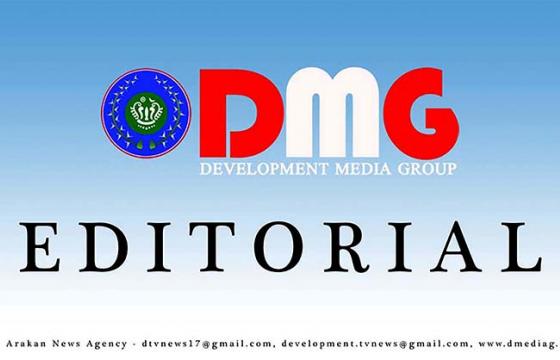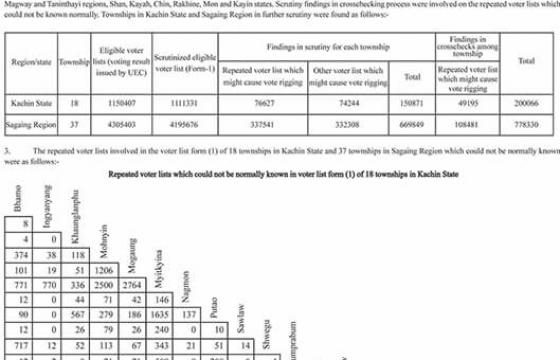The much awaited Union Peace Dialogue Joint Committee (UPDJC) meeting from 28 to 29 October in Naypyitaw was hailed as a step forward in conducting the peace process. But whether this forcefully pushed agenda would really stimulate the ongoing snail-paced movement is the topic that needs more in-depth observation.
From the outset, the UPDJC, which is supposed to be made up of all-inclusive stakeholders, is not at all inclusive, especially where the warring parties or the Ethnic Armed Organizations (EAOs) are concerned.
The Nationwide Ceasefire Agreement (NCA) signatory eight EAOs, that are members of the UPDJC, only have two armies that field over five or more thousands troops, one army has around a thousand and the rest are small armed groups varying from fifty to a few hundreds. But the ethnic armies that are outside the fold, which are thirteen in all, has thrice more troops, if not more according to available conservative estimate.
The United Nationalities Federal Council (UNFC) is an alliance made up of seven ethnic armies, while one -Karen National Union (KNU)- has suspended its membership due to disagreement over signing the NCA and two – Myanmar National Democratic Alliance Army (MNDAA) and Ta’ang National Liberation Army (TNLA) – have handed in their resignation because of the government’s exclusion of them from the peace process and unsatisfactory military backing from the ethnic military alliance, when they were massively attacked by the Burmese military.
The rest EAOs that have not signed the NCA are United Wa State Army (UWSA), National Democratic Alliance Army (NDAA), Arakan Army (AA) and National Socialist Council of Nagaland-Khaplang (NSCN-K).
Aung San Suu Kyi didn’t hide her frustration, when she during her opening speech on 28 October said: “We need to find ways on how to include the groups that have not yet sign (the NCA). The non-signatory groups would also need to be enthusiastic about it. Termination of the conflict is the only way. Without ending the conflict, there is no way peace could be achieved. Therefore, we all must aim for the termination of conflict.”
She further stressed: “So, all must help to think (about it). Don’t drag the time too long.”
With clear indication to counter criticism to her hush-hush pushing of the peace process, particularly with regards to the non-signatory EAOs’ complaint, she said: “Some told me to give more time. It is not that I don’t want to give more time, but don’t like to drag the time. Giving time and dragging time is different. Giving time is to give time in order to finish the necessary work. Dragging time is giving various reasons because of not wanting to make decision by (intentionally) dragging the time.”
She made her point by saying: “Time and tide wait for no man. This (allotted) time needs to be made use of in a correct way.”
She further stressed that the country has been hungering for peace for decades and that how much time do the stakeholders need to realize it, adding: “I would like to urge to take time in discussion within the conference,” which in effect means not to hinder the peace conference by staying outside.
The only problem with Suu Kyi’s urging is that bilateral ceasefire, the military offensives and all-inclusiveness and equitable participation of all EAOs, on all levels of the peace process, are not yet ironed out, so that the non-signatories could come in, sign the amended NCA that covers the EAOs’ aspirations and participate in the peace conference.
The argument of Suu Kyi, which seems to bank on “let us sign now and iron out the outstanding issues later” doesn’t work here, as the core basic necessary rules that is essential to have a basis of “level playing field” is starkly violated, which is the cornerstone of any durable, lasting political settlement.
And thus, the Suu Kyi’s argument of “Time and tide wait for no man” clashes violently with the peace study notion of “ Nothing is agreed until everything is agreed.”
Burma Army Offensives
To add more confusion and as if to weaken the Suu Kyi’s argument, the military has been actively bombarding Kachin Independence Army (KIA) positions, while the UPDJC meeting was still in process.
According to Kachin sources and Gum San, Chairman of the Kachin Alliance based in the United States, on 28 October KIA positions near Laiza headquarters were bombarded and attacked by the Burma Army to achieve military strategic edge, which is detrimental to the peace process.
Gum San, regarding the bombardment said: “Shooting occurred near our headquarters. For example, on 28 October, the outpost Gidon was bombarded 17 times with 82 mm cannon.”
Mai Ja Yang based Federal Law Academy’s headmaster Aung Htoo is of the opinion that without agreement on contractual obligation, going ahead with the political dialogue would reach nowhere.
He pointed out correctly, when he said: “ Unless the treaty (NCA) is basically altered that it is acceptable for the EAOs, framework for political dialogue would not be effective.”
The UNFC has tabled an eight point proposal to be included in the NCA, so that they could sign it. The basic call of this proposal are bilateral ceasefire declaration, all-inclusiveness and equitable participation in all levels of the peace process.
According to 31 October report of Kachin News Group (KNG), on the 56th anniversary of the founding of the Kachin Independence Organization (KIO), their Chairman, General Lanyaw Zawng Hra, warned in a speech that the Burma Army’s ongoing offensive against all eight of the KIO’s brigades, was making peace more difficult.
He said that while the Burmese government says it is trying to continue to maintain a dialogue with armed groups, the Burma Army has been increasing its military offensives.
He argued that the new Burmese government has not been able to stop the military offensives launched by the Burma Army. Instead the government has blamed the non-signatories of the nationwide ceasefire agreement (NCA), like the KIO and claimed that they do not desire peace even though the National League for Democracy (NLD) has called for ‘building a genuine federal union together’ during the election campaign.
The KIO chairman alleged in his speech that the Burma Army has been trying to control the KIO headquarters through military means in order to make the group sign the NCA and defeat the armed groups through the “DDR” (disarmament, demobilization, and reintegration).
UPDJC Meeting
According to the government’s Global New Light of Myanmar, the UPDJC meeting was held for two days, from 28 to 29 October, when the draft structure for political dialogue, work guidelines – or Terms of Reference (TOR) – for national level political dialogues, regional level political dialogues, content-based or issue-based national level political dialogues, supervisory committee of the UPDJC, the UPDJC, the UPDJC Secretariat, work committees and the UPDJC Office organizational structure and topics to be discussed at the first national-level political dialogues were drawn up.
The gathering, which is the eighth meeting since the signing of NCA on 15 October 2015, was said to have made 9 decisions and 8 meeting records.
Reportedly, the pilot project, national-level political dialogues will begin in some regions and states that are ready to host them.
UPDJC, the highest organ in directing the country’s political dialogue, is made up of 16 members each from three blocs: government, parliament and military; Ethnic Armed Organizations (EAOs); and political parties, which the UNFC and other non-signatory EAOs that have still to sign the NCA are not represented or included in the set up.
Outlook
The pilot project in some ethnic areas, regions and issue-based national-level political dialogue, which would provide with inputs for a wider national-level political dialogue is a good way out for the short term. But it is far from being a comprehensive solution that would empower the union-level, second 21st Century Panglong Conference (21CPC). The first one, officially known as the Union Peace Conference 21st Century Panglong, under Suu Kyi initiative was held on 31 August of this year.
In elaborating her pilot projects, Suu Kyi explained: “We would arrange so that all could participate. Therefore, I think it is now time to experiment national-level discussions. Why I have to say it is experimental period is that because we can’t do it all over the country at the same time.”
The recent political maneuver seems to be pushing the final decision making-process back to buy time, as Suu Kyi knows going ahead stubbornly with the reason of having no time to wait and non-all-inclusive approach would be doomed to fail. A clever move, it might seem, but Suu Kyi won’t be able to dodge the problem for too long.
Sai Nyunt Lwin, general secretary of the Shan Nationalities League for Democracy (SNLD), on 29 October, told Shan Herald Agency for News (SHAN), during the Committee for Shan State Unity (CSSU) meeting in Rangoon: “National-level political dialogue is in reality still just a thinking and could be seen only in the chart. (We) cannot be doing according to ethnic, region and issue-based. The framework for political dialogue is not also been endorsed and going ahead without endorsement is a waste of energy. We will have to wait and see until November.”
Sai Nyunt Lwin further stressed: “I think national-level political dialogue is still quite far away. Actually, the CSSU doesn’t know of national-level political dialogue and it is just a coincidence.”
CSSU, formed a few years ago, is made up of two Shan political parties, two Shan armies, one people’s militia and several Civil Society Organizations.
As it is now, Suu Kyi has to weigh in to persuade the military to stop its war of aggression and offensives on the EAOs both signatories and non-signatories, in the first place. Lashing out and blaming both warring parties – the military and the EAOs – won’t be enough to move the process forward, in an objective manner.
As for the UNFC, it is more inclined to amend the NCA than participating as unofficial observer status in the Framework for Political Dialogue (FPD) meetings and amendments, where it has no official say or voting rights. It has also made it clear its position, with its eight point proposal to be included in the NCA, which centers around bilateral ceasefire declaration, all-inclusiveness and equitable composition of participation in all levels of peace process. In other words, creating a level political playing-field is its priority.
From the government side, the logic of FPD amendment undertaking, which was pulled through during the last two months was that the UNFC might develop a sense of co-ownership of the process, which was quite far-fetched. Yet, another wishful thinking from the side of the military and government might also be that personal contact could lead to easier accommodation for each other entrenched positions.
Thus, in sum, no amount of Suu Kyi’s urging or blame game would move the UNFC to sign the NCA, unless the said basic required core points, which would lead to the creation of level playing field, are met.
The pilot project of state and regional level political dialogue might be able to give more inputs to the union-level political dialogue, still “the cart before the horse” scenario is the reality and wouldn’t change. In other words, ironing out the basic document of NCA so that all could participate is the first priority and only after this could the FPD and national-level political dialogue could follow, without much hustle.
But by continuing the strategy of cart before the horse, the UNFC and the rest of non-signatory EAOs will be out in the cold and the Suu Kyi initiated 21CPC would continue to be only a gathering of partial-ceasefire groups, combined with the government, military and political parties, with the war raging in Shan and Kachin states, if not on a more wider scale.
It is time that Suu Kyi should start thinking to place the horse in front of the cart and not vice versa.






